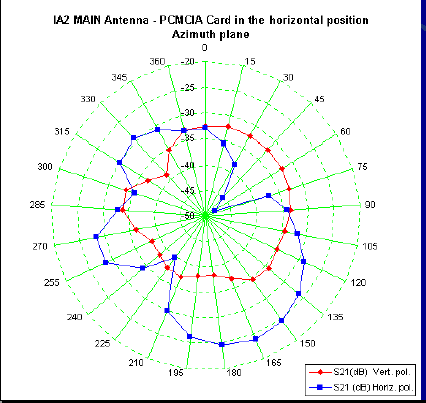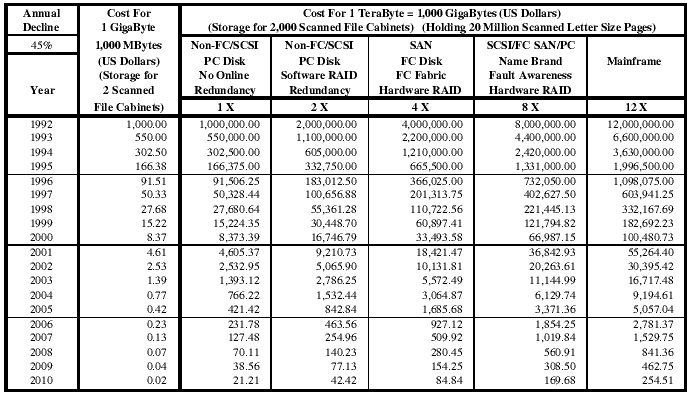2002-12-04»
nice lobes»
Much more detailed info than the keynote is Trevor Marshall‘s talk on security and antenna design and how not to leak signals in directions you don’t want. Or, alternately, given that Marshall designed a parabolic feed that secured a 125Km WiFi link using standard Cisco cards, how to leak in exactly the directions you do want.) I suspect the talk is similiar to the one he gave to the SoCal Wireless Users group, which is streamed on the Linux Public Broadcasting Network if you want to learn more.
He also has some ugly-ass plots of PCMCIA antenna signal strengths (below – the two colours are different polarisations). WiFi card signals are all over the place, which I found out to my cost when I was trying to write a triangulating utility a while back.

Comments Off on nice lobes
um-boingo»
I’m blogging Sky Dayton‘s keynote at 802.11 planet. There’s not been much that’s new, but it’s a nice overview of Sky’s take on the market.
Sky’s “ah-ha” moment was when he was in Aspen, and he saw three APs in his hotel room. Two turned out to be wireless ISPs – both of whom starting scrapping between each other to talk to him. Reminded him of early days of Earthlink.
Survey says: 97% of travelling businessmen would alter their plans to gravitate to high-speed access (high-speed access is more important to them than wireless access)
Ubiquity in laptops – Dell will be putting WiFi in their laptops by default, new iPaq will have WiFi built in.
He sees WiFi in cellphones, cars, gameboys. How low can the power go on these things, I wonder? There must be some physical limit. Maybe we just need more sensitive APs? Sorry, mind wandering – back to Sky.
Only 3,000 commercial hotspots in the US – about a million potential locations (212 conference centers, 3032 train stations, 5352 airports, 72,720 business centers, 202,600 gas stations, 480,298 restaurants and cafes, 1,111,300 retail stores. Wow. There are more airports than train stations in the US.)
But how do you get to ubiquity?
Dayton compares it to early days of ISPs (“Nobody knew who was their customer and who was their competition”). Back then, everybody tried to do everything – owning the wires, the network, and the brands. Eventually each company concentrated in one area – end users are AOL, MSN, networks are UUNET etc, wires are the telcos. (Hmmm. Has this happened in broadband yet?)
Dayton’s division in the WiFi market is: Venues (Mariot, Hilton, Borders, etc). Hot Spot Operators: “(Wayport, T-Mobile, Surf and Sip, etc). Aggregators, who take the fragmented networks and provide cohesion: Boingo, GRIC, iPass. And brands: Boingo, T-Mobile, Earthlink, Sprint, Cingular, AT&T.
Big potential, says Sky, is in Hot Spot Operators. Two aggregators max. But he would say that…
He believes that no one HSO (Hot Spot Operator) will be able to deploy more than 10% of the total footprint – because WiFi’s short range, low barrier to entry, and venue fragmentation. If your brother runs a chain of coffee shops, you could set up a HSO and roll it out, and steal past any bigger HSO. That’s why aggregators are necessary.
Mac version of Boingo sniffer in Q1 2003. Not much talk about *how* it aggregates with HSO.
Some nattering about Hot Spot in a Box – allows any access point becomes a commercial hot spot. Costs $500 includes hardware, will drop to $300 as they talk to major manufacturers — any broadband end point could become a hotspot. There must be a way of turning that into a software app. What kind of cut do these Boingo resellers get?
Hardware with Boingo built-in: Nomadix, Colubris, and Vernier. Fairly minor players. Client software carried with Orinoco, D-Link, SMC, Netgear, HP laptops, Earthlink (doh), Fiberlink. Yeah, but who pays attention to the CDs in the box?
Audience seem a bit underwhelmed. You can see that WiFi is taking off: lots of low-attention-span wide-eyed MBA wolverines sniffing and snarling their business plans on the floor. They already know Sky’s overview – they want to know what everyone is going to do for them, or what they can do to everyone else.
The conference is much much bigger than last year, but I think the smarts has got a bit more dilute. Ah, well – once more into the J-curve…
Now, should find Glen and feed him some Theraflu?
Comments Off on um-boingo
waiting for the exabyte drive»
A friend wrote asking me if a petabyte would be an affordable amount of disk storage in five years time. Blowed if I know, but in scrabbling to answer, I did find this great projection of the next twenty years of magnetic storage. It contains this graph which is based on IBM estimates of future storage capacity and price. (which I couldn’t be bothered to convert into HTML – hey, but maybe you will and sent the text to me. Updated 2004-07-11: For my birthday, Adrian Furby sent me this HTMLised. Thanks, Adrian!)

| Annual Decline |
Cost for 1 GigaByte
1,000 MBytes
(US Dollars)
(Storage for 2 Scanned File Cabinets) |
Cost For 1 TeraByte = 1,000 Gigabytes (US Dollars)
(Storage for 2,000 Scanned File Cabinets) (Holding 20 Million Scanned Letter Pages) |
| 45% |
Non-FC/SCSI
PC Disk
No Online Redundancy |
Non-FC/SCSI
PC Disk
Software RAID Redundancy |
SAN
FC Disk
FC Fabric Hardware Raid |
SCSI/FC SAN/PC
Name Brand
Fault Awareness Hardware Raid |
Mainframe |
| Year |
1 X |
2 X |
4 X |
8 X |
12 X |
1992
1993
1994
1995 |
1,000.00
550.00
302.50
166.80 |
1,000,000.00
550,000.00
302,500.00
166,375.00 |
2,000,000.00
1,100,000.00
605,000.00
332,750.00 |
4,000,000.00
2,200,000.00
1,210,000.00
665,500.00 |
8,000,000.00
4,400,000.00
2,420,000.00
1,331,000.00 |
12,000,000.00
6,600,000.00
3,630,000.00
1,996,500.00 |
1996
1997
1998
1999
2000 |
91.51
50.33
27.68
15.22
8.37 |
91,506.25
50,328.44
27,680.64
15,224.35
8,373.39 |
183,012.50
100,656.88
55,361.28
30,448.70
16,746.79 |
366,025.00
201,313.75
110,722.56
60,897.41
33,493.58 |
732,050.00
402,627.50
221,445.13
121,794.82
66,987.15 |
1,098,075.00
603,941.25
332,167.69
182,692.23
100,480.73 |
2001
2002
2003
2004
2005 |
4.61
2.53
1.39
0.77
0.42 |
4,605.37
2,532.95
1,393.12
766.22
421.42 |
9,210.73
5,065.90
2,786.25
1,532.44
842.84 |
18,421.47
10,131.81
5,572.49
3,064.87
1,685.68 |
36,842.93
20,263.61
11,144.99
6,129.74
3,371.36 |
55,264.40
30,395.42
16,717.48
9,194.61
5,057.014 |
2006
2007
2008
2009
2010 |
0.23
0.13
0.07
0.04
0.02 |
231.78
127.48
70.11
38.56
21.21 |
463.56
254.96
140.23
77.13
42.42 |
927.12
509.92
280.45
154.25
84.84 |
1,854.25
1,019.84
560.91
308.50
169.68 |
2,781.37
1,529.75
841.36
462.75
254.51 |
As you can see, a petabyte will still cost about $70,000 in 2008. Consolation prize: a terabyte will sell for $70. Better start saving those files now!
Comments Off on waiting for the exabyte drive
so much for the protection of copyright»
According to a cursory IMDB search, Jason Schultz has discovered that 93% of the movies released from 1927-1946 are unavailable (it’d be interesting to include current TV showings in this – what was that site that let you grep through US TV listings for keywords?). As an interesting aside, the IMDB has 36,386 titles for that period. The copyright office says there are 37,144 – which means that the IMDB, a largely amateur effort, has snagged 98% of the titles. All goes to show that Kevin Kelly’s assertion that enthusiasts might be better at preserving film history than paid copyright holders might turn out to be true. (Off of the rc3.org)
Comments Off on so much for the protection of copyright


